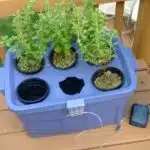Maintaining healthy soil is essential for any horticulturist. When the soil lacks vital nutrients, plants struggle to grow correctly and produce a healthy yield. One of the most crucial elements for plant growth is phosphorus. Adding phosphorus to soil can improve root development, increase plant growth, and help plants withstand environmental stressors such as drought.
There are several ways to add phosphorus to soil, each with its advantages and disadvantages. In this article, we will explore eight different methods of adding phosphorus to your soil, from organic options such as bone meal and manure to synthetic fertilizers. By understanding how to add phosphorus effectively, you can help ensure your plants have what they need to thrive, providing yourself or others with more abundant yields of delicious fruits and vegetables.
Understanding The Importance Of Phosphorus In Soil
Phosphorus is an essential nutrient that plays a significant role in the growth and development of plants. It is one of the three primary macronutrients, along with nitrogen and potassium, required for healthy plant growth. Phosphorus is crucial in agriculture as it promotes root development, improves seed production, and enhances overall plant health.
Phosphorus deficiency symptoms in plants can be challenging to identify as they often resemble other nutrient deficiencies. Some common symptoms include stunted growth, purplish or reddish leaves, and poor flower or fruit production. However, these symptoms may vary depending on the plant species and soil conditions.
To ensure optimal phosphorus levels in your soil, it is essential to understand the importance of phosphorus in agriculture and recognize the signs of phosphorus deficiency in plants. By doing so, you can take proactive steps to provide your plants with adequate amounts of this vital nutrient. In the next section, we will discuss how to test your soil for phosphorus levels to determine whether additional supplementation is necessary.
Testing Your Soil For Phosphorus Levels
Coincidentally, the success of adding phosphorus to soil depends on your ability to determine its levels in the first place. Soil testing methods are essential in determining the levels of phosphorus in your soil. You can either send a sample of your soil to a laboratory for professional testing or use a home testing kit.
Interpreting soil test results is crucial as it helps you know how much phosphorus is available in your soil and what actions you need to take to increase or decrease it. Soil-test results will give you recommendations on how much fertilizer to add based on the nutrient composition of your soil. The interpretation of test results also provides valuable information about other nutrients such as nitrogen and potassium that might be lacking in your soil.
As a horticulture expert, I recommend getting into the habit of regularly testing your soil every few years. This practice ensures that you maintain optimal nutrient levels and avoid over-fertilization, which can lead to environmental problems such as water pollution. Knowing the levels of phosphorus in your soil will help you decide on the best method for adding phosphorus without causing imbalances with other nutrients present. With this knowledge, we can now delve into organic methods of adding phosphorus to soil, which we will discuss in detail in the subsequent section.
Organic Methods Of Adding Phosphorus To Soil
Phosphorus is a crucial nutrient essential for the healthy growth of plants. However, some soils may lack adequate amounts of this nutrient, leading to stunted growth and poor yields. Fortunately, there are several organic methods that gardeners can use to add phosphorus to their soil.
One effective method is using composting techniques. Composting involves decomposing organic materials like kitchen scraps, grass clippings, and leaves into a nutrient-rich soil amendment that can be added to the garden soil. As the organic material breaks down, it releases phosphorus and other nutrients back into the soil in a form that plants can easily absorb. This method not only adds phosphorus but also helps improve soil structure and fertility.
Another way to add phosphorus organically is by using natural sources such as rock phosphate and bone meal. Rock phosphate is a mined mineral that contains high levels of phosphorus in a form that slowly releases over time, making it ideal for long-term soil fertility improvement. Bone meal, on the other hand, is made from ground animal bones and contains high levels of phosphorus in an easily absorbed form by plants. Both rock phosphate and bone meal can be incorporated into garden soil before planting or applied as a top dressing during the growing season.
An additional organic method for adding phosphorus to soil is by growing specific cover crops like clover or alfalfa that have deep roots capable of mining nutrients from deeper layers of the soil and bringing them up into the topsoil where they become available for other plants. These cover crops also help fix nitrogen in the soil, further improving overall fertility levels.
Using bone meal to boost phosphorus will provide your plants with an immediate source of this vital nutrient. It’s easy to apply bone meal either by mixing it into your garden beds before planting or by sprinkling it around established plants during the growing season. Bone meal is an excellent choice for gardeners who want to boost phosphorus levels in their soil quickly.
Using Bone Meal To Boost Phosphorus
Picture this: you’re a gardener, and your plants are your children. You want them to grow up healthy and strong. Just like children need the right nutrients to thrive, so do plants. Phosphorus is an essential nutrient for plant growth, and bone meal can be a great way to boost phosphorus levels in soil.
Bone meal is made from ground-up bones, often from cows or pigs. It’s a natural source of phosphorus, as well as calcium and other minerals that plants need to grow. One of the pros of using bone meal is that it’s organic and slow-release, meaning it won’t harm your plants with too much phosphorus all at once. However, there are also some cons to using bone meal. For one thing, it can attract pests like dogs and raccoons who smell the meaty scent of the bones. Additionally, if you use too much bone meal or apply it incorrectly, it can lead to nutrient imbalances in your soil.
To properly apply bone meal to soil, you’ll want to mix it into the top layer of soil before planting new seeds or seedlings. Follow the instructions on the package carefully – different brands may have different recommendations for how much bone meal to use per square foot of garden space. Be sure not to overdo it – too much phosphorus can actually inhibit plant growth rather than promoting it.
Next up: applying compost to increase phosphorus levels in soil without breaking the bank.
Applying Compost To Increase Phosphorus
Transition from Previous Section:
Now that we have discussed how bone meal can be used to boost phosphorus levels in the soil, let’s move on to another effective method – composting.
Subsequent Section: Applying Compost to Increase Phosphorus
Composting is a natural and sustainable way of enriching soil with essential nutrients, including phosphorus. The process of composting involves breaking down organic matter into a nutrient-rich fertilizer that can be added back into the soil. There are several benefits of composting, such as reducing waste, improving soil structure and fertility, and promoting plant growth.
There are two main types of composting methods – aerobic and anaerobic. Aerobic composting requires oxygen and involves turning the compost pile regularly to promote decomposition. This method produces high-quality compost quickly but requires more effort and management. Anaerobic composting does not require oxygen and is slower but less labor-intensive. This method is ideal for those who have limited space or time for managing a compost pile.
Using compost as a fertilizer is an excellent way to add phosphorus to your soil naturally. It helps improve soil quality while providing essential nutrients needed for healthy plant growth. In the next section, we will discuss another common method of adding phosphorus to your soil – using manure.
Using Manure To Add Phosphorus To Soil
Picture yourself walking through a vast pasture teeming with animals. The lush green grass, the chirping of birds, and the smell of manure wafting in your nostrils. Manure has been used for centuries as a natural fertilizer to improve soil health and increase crop yield. It is rich in essential nutrients such as nitrogen, potassium, and phosphorus that are vital to plant growth.
Manure composition varies depending on the animal source and diet. Cow manure contains more phosphorus than nitrogen and potassium, while chicken manure is high in nitrogen. Therefore, it’s crucial to know the nutrient composition of your manure before applying it to avoid nutrient imbalance in your soil. Applying too much manure can also lead to environmental pollution from runoff.
Application frequency is another critical factor when using manure as a fertilizer. Over-application can cause excessive salt buildup in your soil, which can harm plants’ roots and reduce their ability to absorb water and nutrients from the soil. Manure should be applied at least one month before planting and not more than once every growing season. Proper application will ensure that you reap maximum benefits from this organic fertilizer.
Utilizing cover crops for phosphorus enrichment is another effective way of improving your soil’s health.
Utilizing Cover Crops For Phosphorus Enrichment
Transition: Using manure is a great way to add phosphorus to the soil, but it may not be enough for some gardens. In such cases, cover crops can offer an alternative solution.
Cover crop benefits are numerous. Not only do they help suppress weed growth and erosion, but they also improve soil health by adding organic matter and increasing beneficial microbial activity. Cover crops can also serve as a source of nitrogen fixation or act as a biofumigant, suppressing soil-borne pests and diseases. When selecting cover crops for phosphorus enrichment, it’s important to consider their ability to scavenge nutrients from deep within the soil profile while also being able to release those nutrients back into the topsoil when they decompose.
Some of the best cover crop options for phosphorus supplementation include legumes such as clovers and beans, which have symbiotic relationships with nitrogen-fixing bacteria that can access otherwise unavailable soil nitrogen. Brassicas like mustard are also good choices because they contain high levels of glucosinolates that break down into compounds toxic to pest nematodes in the soil. Other options include annual ryegrass, oats, and barley. Keep in mind that different cover crop species offer varying degrees of nutrient uptake efficiency and decomposition rates depending on environmental factors like temperature and moisture levels.
Transition: While using cover crops is an excellent way to enrich your soil with phosphorus naturally, there may be instances where synthetic fertilizers are needed for more immediate results.
Synthetic Fertilizers For Phosphorus Supplementation
As the saying goes, “a little goes a long way,” but the same cannot be said for phosphorus in soil fertilization. Excess application of synthetic fertilizers can lead to phosphorus toxicity, which can have detrimental effects on plant growth and soil health. As such, it is essential to understand sustainable fertilization methods that can supplement phosphorus without causing harm.
One sustainable method of phosphorus supplementation is through the use of rock phosphate. This natural mineral contains high levels of phosphorus and other trace elements that are necessary for plant growth. Rock phosphate can be applied directly to the soil or mixed with compost for added nutrients.
Another organic option for phosphorus supplementation is bone meal. Made from finely ground animal bones, this slow-release fertilizer provides a steady supply of phosphorus to plants. However, caution should be exercised when using bone meal as it may attract unwanted pests.
A third sustainable method for adding phosphorus to soil is through the use of green manure crops like clover or alfalfa. These crops fix atmospheric nitrogen into the soil while also providing organic matter and nutrients like phosphorus as they decompose. Additionally, green manure crops help improve soil structure and water retention.
Understanding sustainable methods for adding phosphorus to soil is crucial in maintaining healthy plant growth and preserving long-term soil fertility. While synthetic fertilizers may offer quick results, they come with their own set of pros and cons that must be carefully considered before use.
Understanding The Pros And Cons Of Synthetic Fertilizers
As discussed in the previous section, synthetic fertilizers are a popular method for supplementing phosphorus in soil. While they do offer certain advantages, there are also several disadvantages to consider. One of the main advantages is that synthetic fertilizers are readily available and easy to apply. They also provide a quick boost of nutrients to plants, which can be especially beneficial for crops that require higher levels of phosphorus. However, there are also significant environmental impacts associated with the use of synthetic fertilizers.
The sustainability of synthetic fertilizers is a growing concern for many horticulture experts. These products often contain high levels of chemicals and other harmful substances that can leach into the soil and water supply over time. This can lead to a range of issues including reduced soil fertility, increased pollution, and even health problems for humans and animals alike. Additionally, the production and transportation of synthetic fertilizers requires significant amounts of energy and resources, further contributing to their environmental impact.
Despite these drawbacks, many gardeners continue to rely on synthetic fertilizers as a primary source of phosphorus supplementation. However, it is important to consider alternative methods for maintaining soil health and promoting sustainable plant growth. In the next section, we will explore one such method – applying phosphorus in liquid form – as well as its benefits and potential drawbacks.
Applying Phosphorus In Liquid Form
Liquid phosphorus application is another popular method of adding phosphorus to soil. This method involves mixing water-soluble phosphorus fertilizer with water and applying it directly to the soil. Liquid phosphorus fertilizers are available in many forms, including suspensions, solutions, and emulsions.
Benefits of liquid phosphorus application include its fast-acting nature and ability to quickly correct deficiencies in plants. Additionally, liquid fertilizers are easier to apply uniformly across a large area when compared to granular fertilizers. However, there are also drawbacks to this method of application. Liquid fertilizers tend to be more expensive than granular options and require more frequent applications since they are more prone to leaching.
Best practices for liquid phosphorus application will vary depending on the type of soil you have. Sandy soils tend to require smaller amounts of fertilizer applied more frequently, while clay soils can benefit from larger amounts applied less frequently. It is important not to overapply liquid fertilizer as this can lead to excess nutrients in the soil which can harm both plant growth and nearby ecosystems.
In the next section, we will explore using rock phosphate for long-term soil health. While liquid phosphate may be a quick fix for immediate plant needs, rock phosphate offers a more sustainable solution for maintaining healthy levels of phosphorous in your soil over time.
Using Rock Phosphate For Long-Term Soil Health
Rock phosphate is considered the most efficient source of phosphorus for long-term soil health. It is a naturally occurring mineral which can be found in many parts of the world and is an essential nutrient for plant growth. The benefits of using rock phosphate include an increase in soil fertility, improved soil structure and an overall increase in crop yield. The application of rock phosphate can be done in numerous ways including compost, manure, liquid fertilizers, animal feed, and more.
Benefits Of Rock Phosphate
Rock phosphate, a type of natural mineral, is an excellent way to add phosphorus to soil for long-term health. It is sourced from mined deposits that contain high levels of phosphorus and other essential nutrients needed by plants. When used properly, it can provide numerous benefits that help improve soil quality and plant growth.
One of the main benefits of using rock phosphate is its ability to release phosphorus slowly over time. This means that plants can access this nutrient as they need it, which helps prevent over-fertilization and reduces the risk of nutrient runoff. Additionally, since rock phosphate is a natural product, it has a minimal environmental impact compared to synthetic fertilizers. This makes it an ideal choice for those who want to grow healthy plants without harming the environment.
When using rock phosphate, it’s important to choose a reputable source that provides high-quality products. Look for companies that use sustainable mining practices and have a commitment to minimizing their environmental impact. By doing so, you can ensure that you are getting a product that not only benefits your plants but also supports responsible environmental stewardship.
In conclusion, using rock phosphate for long-term soil health offers many benefits such as slow release of phosphorus and minimal environmental impact. As horticulture experts, we recommend sourcing from reputable companies with sustainable mining practices to ensure the highest quality product possible. Incorporating rock phosphate into your gardening routine will lead to healthier plants and support responsible environmental practices at the same time.
Application Of Rock Phosphate
Now that we have discussed the benefits of using rock phosphate for long-term soil health, let us move on to the proper application techniques. The first step in applying rock phosphate is to determine the phosphorus needs of your soil. You can do this by conducting a soil test and analyzing the results. Based on your soil test, you can then determine how much rock phosphate you need to apply.
Once you have determined the amount of rock phosphate needed, it’s time to apply it to your soil. Rock phosphate should be applied evenly across your garden beds or fields and worked into the top 4-6 inches of soil. It’s important not to overapply rock phosphate as it can lead to nutrient imbalances and potentially harm plants. A good rule of thumb is to apply no more than 100 pounds per acre per year.
Lastly, when sourcing rock phosphate, it’s important to ensure that it comes from a reputable company that uses sustainable mining practices. This ensures that you are getting a high-quality product that not only benefits your plants but also supports responsible environmental stewardship. By following these proper application techniques and sourcing guidelines, you can effectively use rock phosphate for long-term soil health and grow healthy plants without harming the environment.
Incorporating Phosphorus Into Planting Holes
Rock phosphate is a highly effective way of adding phosphorus to soil, as it provides a long-term solution for improving soil health. However, there are other ways to add phosphorus to the soil, and planting techniques can be adjusted to ensure that plants have access to this important nutrient. Soil preparation is key when it comes to incorporating phosphorus into the planting holes.
One simple way to add phosphorus is by using bone meal, which is made from ground animal bones and contains high levels of phosphorus. This can be added directly to the planting holes or mixed into the soil prior to planting. Another option is fish emulsion, which can be used as a liquid fertilizer during the growing season. Compost tea can also be brewed from compost that has been enriched with bone meal or rock phosphate.
Incorporating organic matter into the soil can also improve phosphorus availability. Adding manure or leaf mold can increase soil fertility and help break down organic matter in the soil, releasing valuable nutrients like phosphorus. Additionally, crop rotation and cover cropping can help reduce pest and disease pressure while improving overall soil health. By following these planting techniques and preparing the soil properly, gardeners can ensure that their plants have access to adequate levels of phosphorus for optimal growth.
Top-dressing with phosphorus-rich amendments is another effective way of ensuring that plants receive adequate levels of this important nutrient. In the next section, we will explore some top-dressing options that gardeners may consider when looking to boost their soil’s phosphorus content and promote healthy plant growth.
Top-Dressing With Phosphorus-Rich Amendments
One of the best ways to add phosphorus to soil is through top-dressing with phosphorus-rich amendments. This method involves applying a layer of organic or inorganic amendments to the soil surface, which then slowly release the essential nutrient over time. Types of amendments that are commonly used for this purpose include bone meal, rock phosphate, and fish bone meal.
When it comes to choosing the right amendment for your soil, it’s important to consider its composition and optimal application rates. For instance, bone meal is high in both phosphorus and calcium, making it ideal for soils that lack both nutrients. On the other hand, rock phosphate is a slow-release fertilizer that can provide long-lasting benefits but requires higher application rates. Additionally, fish bone meal is a good option for those looking for an organic source of phosphorus.
Overall, top-dressing with phosphorus-rich amendments can be an effective way to boost soil fertility and plant growth. However, it’s important to use these amendments in moderation and monitor soil levels regularly to avoid over-application. In the next section, we will explore how to balance phosphorus with other nutrients to ensure optimal plant health and growth.
Balancing Phosphorus With Other Nutrients
Maintaining balanced soil nutrition is crucial for plant growth and health. Phosphorus is an essential nutrient for plant development, but it must be balanced with other micronutrients to avoid deficiencies or toxicities. One way to achieve this balance is by monitoring and adjusting soil pH levels.
Phosphorus and micronutrient balance can be a delicate dance in the soil. Elevated phosphorus levels can lead to deficiencies in other essential nutrients like zinc, copper, and iron. Conversely, a lack of phosphorus can cause stunted growth and poor yield. It’s crucial to understand the interplay between phosphorus and other micronutrients to maintain a healthy balance for your plants.
Soil pH plays a critical role in the availability of nutrients like phosphorus. When soil pH levels are too high or too low, certain nutrients may become unavailable to plants. For example, at extremely low pH levels (acidic soils), aluminum toxicity can occur, which can lead to stunted root growth and reduced uptake of water and nutrients. Monitoring soil pH levels regularly will help ensure that the proper balance of nutrients is available to your plants.
Monitoring And Adjusting Phosphorus Levels Over Time
After balancing the phosphorus levels with other nutrients in the soil, it is important to monitor and adjust the phosphorus levels over time. Measuring progress is crucial in determining how much phosphorus needs to be added or removed from the soil. One way to measure progress is by conducting a soil test which determines the amount of phosphorus present in the soil.
Based on the results of the soil test, adjustments can be made to add or remove phosphorus from the soil as necessary. Adjusting frequency depends on various factors such as plant type and growth stage. Plants that require higher levels of phosphorus will need more frequent adjustments compared to plants that need lower levels.
It is important to note that adding too much phosphorus can have negative effects on plant growth and can even harm surrounding ecosystems. Therefore, it is essential to carefully monitor and adjust phosphorus levels over time in order to maintain a healthy balance for both plants and the environment.
Conclusion
Phosphorus is a vital nutrient for plants, playing a significant role in their growth and development. When soil lacks sufficient phosphorus, plants suffer from stunted growth and reduced yields. Therefore, it is essential to understand how to add phosphorus to soil.
To start, it’s crucial to test your soil for phosphorus levels before applying any fertilizers or amendments. This way, you can determine the correct dosage of phosphorus required. Organic methods like bone meal and compost are excellent sources of phosphorus and provide sustainable solutions for long-term soil health.
Incorporating phosphorus into planting holes or top-dressing with phosphorus-rich amendments also aid in increasing the nutrient content of the soil. However, it’s important to balance phosphorus with other nutrients to avoid over-fertilization that can cause more harm than good.
As horticulture experts, we must monitor and adjust our soil’s phosphorus levels regularly. By understanding the importance of this nutrient and utilizing different methods for adding it to the soil, we can promote healthy plant growth and encourage bountiful harvests. Remember that adding too much or too little can be detrimental, so strive for balance in all things gardening-related!
Image Credits
- “File:Red phosphorus in a tube – P 15 .jpg” by Photo by en:User:RTC. (featured)





























